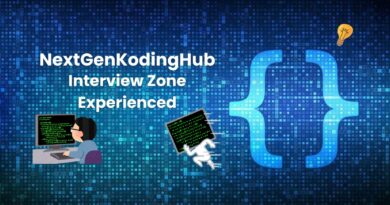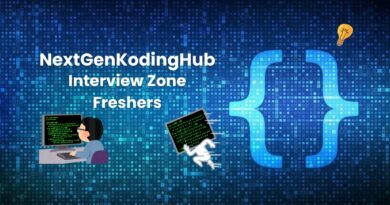Mid-Level and Senior Interviews
Mid-Level and Senior Interviews Preparation
Mid-Level and Senior Interviews – 30+ Critical Questions and Detailed Answers
Preparing effectively for Mid-Level and Senior Interviews is vital to demonstrate your expertise, leadership skills, and problem-solving capabilities. This comprehensive guide offers over 30 frequently asked questions tailored for Mid-Level and Senior Interviews. The questions span technical depth, system design, team management, and strategic thinking, which are key areas recruiters evaluate at this stage.
With this preparation, your understanding of architectural patterns, coding best practices, scalability, and mentoring will deepen, making you confident to excel in Mid-Level and Senior Interviews.
1. How do you approach system design for scalable applications?
I begin by understanding functional and non-functional requirements, then identify key components, data flow, and choose appropriate databases, caching, and load balancing. I also plan for fault tolerance and horizontal scaling.
2. Describe your experience with designing RESTful APIs.
I design RESTful APIs adhering to standards such as statelessness, proper use of HTTP methods, versioning, and secure authentication mechanisms like OAuth2.
3. How do you ensure code quality in your projects?
I enforce coding standards, perform code reviews, use static analysis tools, write unit and integration tests, and automate testing in CI pipelines.
4. Explain a situation where you led a technical project successfully.
I spearheaded the migration of a monolithic application to microservices, coordinated cross-functional teams, defined timelines, and mitigated risks, resulting in improved deployment frequency and system reliability.
5. How do you handle conflicts within your development team?
I encourage open communication, understand different viewpoints, mediate discussions objectively, and focus on shared goals to resolve conflicts.
6. What are design patterns you have used and why?
Common patterns I use include Singleton for shared resources, Factory for object creation flexibility, Observer for event-driven systems, and Strategy for interchangeable algorithms.
7. Describe how you manage technical debt.
I prioritize technical debt during sprint planning, allocate time for refactoring, automate code quality checks, and ensure it does not block feature delivery.
8. How do you optimize database performance?
I analyze query plans, create indexes, use caching layers, optimize schema design, and apply database partitioning or sharding as needed.
9. Explain how you handle deployment failures in production.
I follow rollback plans, use blue-green or canary deployments to minimize impact, analyze logs to identify root causes, and conduct post-mortems to prevent recurrence.
10. How do you mentor junior developers?
I provide regular feedback, share best practices, pair program, and encourage learning through code reviews and knowledge-sharing sessions.
11. What strategies do you use to handle high traffic spikes?
I implement auto-scaling, rate limiting, load balancing, caching, and optimize database queries to handle sudden traffic surges efficiently.
12. How do you balance feature delivery with system stability?
I ensure thorough testing, monitor system health, prioritize bug fixes alongside new features, and collaborate with QA to maintain stability.
13. Explain event-driven architecture and its benefits.
Event-driven architecture decouples components via asynchronous events, improving scalability, responsiveness, and fault tolerance.
14. How do you ensure security best practices in your code?
I validate inputs, use encryption, manage secrets securely, follow OWASP guidelines, and conduct security code reviews.
15. Describe your experience with cloud platforms at scale.
I have managed deployments on AWS and Azure, leveraging services like EC2, Lambda, S3, and Kubernetes, optimizing cost and performance.
16. How do you handle version control and branching strategies?
I use Git with strategies like Git Flow or trunk-based development to manage releases, feature development, and hotfixes efficiently.
17. What metrics do you track to evaluate application performance?
I monitor response time, throughput, error rates, CPU/memory usage, and user engagement to maintain and improve performance.
18. Explain how you design fault-tolerant systems.
I use redundancy, failover mechanisms, graceful degradation, and distributed data storage to ensure system resilience.
19. How do you keep up with evolving technologies?
I regularly read industry blogs, attend webinars, participate in developer communities, and experiment with new tools and frameworks.
20. What is your approach to handling legacy code?
I analyze risks, write tests for critical parts, refactor incrementally, and document changes to improve maintainability.
21. Describe how you optimize build and deployment pipelines.
I automate tasks, parallelize jobs, cache dependencies, and use containerization to speed up builds and reliable deployments.
22. How do you evaluate third-party libraries or tools?
I assess based on community support, licensing, security, compatibility, and performance impact.
23. How do you approach estimating project timelines?
I break tasks into smaller units, consult with stakeholders, factor in risks, and add buffers for uncertainties.
24. Explain how you implement logging and monitoring in production.
I centralize logs, set alerts for anomalies, and use dashboards to visualize metrics and enable quick incident response.
25. How do you deal with cross-team collaboration challenges?
I promote clear communication, set shared goals, use project management tools, and encourage transparency.
26. What are some best practices for API versioning?
Use URL versioning, backward compatibility, deprecation policies, and clear documentation.
27. How do you handle data migrations in production?
I perform migrations in small batches, back up data, test thoroughly, and monitor for issues post-migration.
28. Describe your experience with container orchestration tools.
I have used Kubernetes to manage deployments, scale applications, and implement self-healing strategies.
29. How do you design systems for high availability?
I use redundant components, failover strategies, geographic distribution, and real-time monitoring.
30. How do you approach debugging complex production issues?
I gather logs, reproduce issues if possible, analyze system metrics, collaborate with teams, and apply systematic troubleshooting.
31. What leadership qualities do you bring to technical teams?
I lead by example, empower team members, communicate clearly, and foster a culture of continuous learning.
32. How do you ensure your team adheres to agile methodologies?
I facilitate regular standups, sprint planning, retrospectives, and encourage iterative development with feedback loops.
Conclusion
This extensive set of questions for Mid-Level and Senior Interviews equips you to demonstrate both your technical depth and leadership skills. Thorough preparation using these questions will boost your confidence and help you showcase your expertise effectively. Remember, in these interviews, clear communication and real-world examples of your experiences are just as important as technical knowledge.



